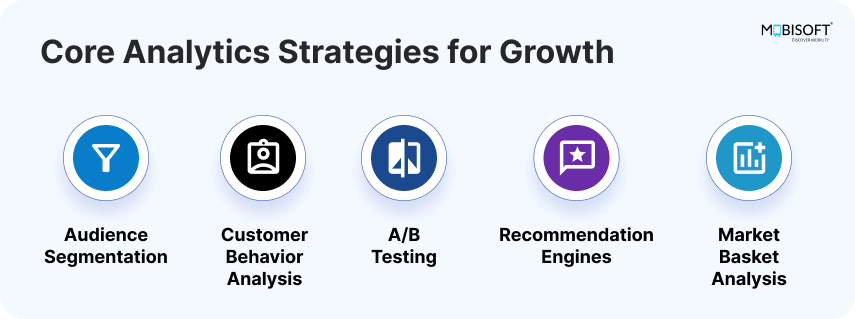E-commerce Analytics Guide to Grow Your Online Store
E-commerce Analytics: The Ultimate Guide to Growing Your Online Store

Data drives every choice in the online marketplace. E-commerce analytics is the foundation that enables sustainable growth, improved strategies, and enduring competitiveness for e-commerce businesses. This guide provides the ammunition to harness the power of e-commerce data analytics for success, drive growth, improve operational efficiency, and build engaging customer experiences that endure.
Introduction: Why Analytics Matters in E-commerce
Operating an online store without e-commerce analytics tools is a shot in the dark. There is some creativity and intuition, but consistent growth relies on facts. E-commerce data insights show you what your customers are looking for, how they act, and where your efforts are translating into results. With that level of transparency, you can focus on what works, building smarter strategies, improving the customer experience, and driving sales with intent.
Source: Ecommerce Analytics: How to Leverage the Power of Data for Your Business
What is E-commerce Analytics?
E-commerce analytics gives you full visibility into everything happening across your online business. It’s about tracking customer behavior analytics, campaign performance, product flow, and identifying e-commerce performance metrics that truly matter. Rather than guessing what’s working, you have facts. These insights help boost your growth rate, enhance operational efficiency, and deliver better customer experiences.
Learn more about our custom e-commerce development services.

Key Benefits of Leveraging Analytics
Informed Decision-Making
Make strategic choices based on facts, not guesswork.
Optimized Marketing
Allocate budget to high-performing channels and campaigns.
Improved Customer Experience
Identify and address pain points in the user journey.
Increased Revenue
Use data to boost conversion rates, average order value, and repeat purchases.
Competitive Advantage
Spot trends and adapt faster than competitors.
If you're planning to scale your store, don't miss these essential e-commerce features that every high-converting platform needs.
Essential E-commerce Analytics Tools
Selecting the right analytics tools for e-commerce is critical for accurate reporting and insights. Here are the top options for 2025:
ToolBest ForKey FeaturesGoogle AnalyticsAll businessesFree, real-time tracking, marketing & sales performanceKissmetricsCustomer behavior & retentionMulti-channel tracking, segmentation, A/B testingOptimizelyWebsite optimization & A/B testingExperimentation, conversion rate optimizationCrazy EggVisual behavior analysisHeatmaps, user session recordingsAdobe AnalyticsEnterprise-level insightsPredictive analytics, deep segmentation, and real-time dataSitecoreCustomer journey & engagementPath analysis, value scoring, and personalization
Source: 5 Best Ecommerce Analytics Tools for 2025
Core Analytics Strategies for Growth

1.Audience Segmentation
Segment your customers based on demographics, behavior, purchase history, and preferences. This enables the customers to be personalized and targeted, thereby improving conversion and customer satisfaction through e-commerce analytics for growth.
2. Customer Behavior Analysis
Track how users navigate your site, what they view, where they drop off, and what drives them to purchase. Use these e-commerce data analytics insights to optimize site layout, product pages, and checkout flows for higher engagement and sales.
3. A/B Testing
Experiment with different versions of landing pages, product descriptions, or checkout processes. Use analytics to determine which variants perform best, then implement the winners to maximize conversions and average order value using e-commerce conversion analytics.
4. Recommendation Engines
Use e-commerce data analytics and machine learning to generate personalized product suggestions, enhancing upsell and cross-sell potential like Amazon and Netflix.
5. Market Basket Analysis
Compare what products are generally purchased together to guide bundling efforts and direct promotions.
Source: How to Use eCommerce Data Analytics to Increase Revenue
Optimizing Marketing Campaigns with Analytics

Measure Campaign Effectiveness
Track the ROI of Google Ads, email marketing, and social media campaigns. Shift budget to the highest performers and refine underperforming tactics.
Forecast Trends
Use historical data to predict demand, plan inventory, and align marketing with seasonal spikes.
Attribution Modeling
Understand which channels and touchpoints contribute most to conversions, enabling smarter allocation of resources.
Personalization and Segmentation
Personalized Offers
Use analytics to deliver dynamic content, tailored discounts, and product recommendations based on user behavior and preferences.
Dynamic Content
Serve unique homepages, emails, and ads to different customer segments for higher engagement and loyalty.
Pricing and Inventory Optimization
Dynamic Pricing
Analyze customer segments, competitor pricing, and demand to set optimal prices for maximum revenue using ecommerce dashboard analytics.
Inventory Analytics
Monitor stock levels, predict demand, and avoid overstocking or stockouts to improve profitability and customer satisfaction.
Merchandising Analysis
Identify trending products and prioritize them in your store layout and promotions, supported by e-commerce KPI tracking, a key component in delivering competitive retail e-commerce solutions.
Learn More: https://mobisoftinfotech.com/resources/blog/ecommerce-retail/ecommerce-analytics-guide
- AI
- Vitamins
- Health
- Admin/office jobs
- News
- Art
- Causes
- Crafts
- Dance
- Drinks
- Film
- Fitness
- Food
- Jogos
- Gardening
- Health
- Início
- Literature
- Music
- Networking
- Outro
- Party
- Religion
- Shopping
- Sports
- Theater
- Wellness


